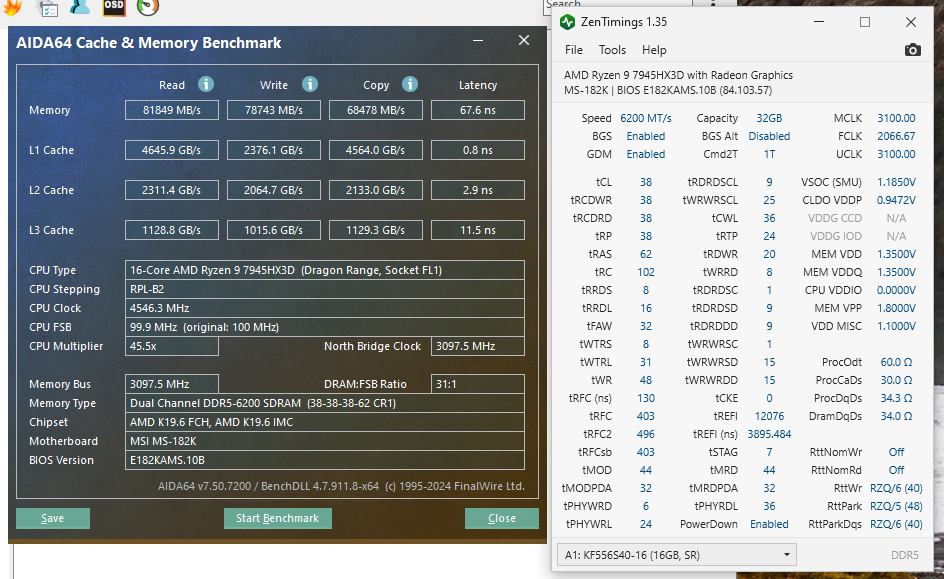
win32asmguy
Member-
Posts
664 -
Joined
-
Last visited
-
Days Won
3
Content Type
Profiles
Forums
Events
Everything posted by win32asmguy
-
*Official Benchmark Thread* - Post it here or it didn't happen :D
win32asmguy replied to Mr. Fox's topic in Desktop Hardware
Its worth around 2000-2500. Hope he extended the warranty too as these came with a 1 year by default I think. You could also look for a ge78. That would overclock memory better and we can get a modded ec to let it boost higher if you tweak the cooling system. -
MSI Titan 18HX Dragon Edition Norse Myth "Official Thread"
win32asmguy replied to electrosoft's topic in MSI
I found some listings for the Raider 18 on ExcaliberPC. 3899usd A9WIG-082US 9955HX3D, 5080M, 2x32GB DDR5-6400, 2TB SSD, UHD+ 120hz miniLED 4899usd A9WJG-052US 9955HX3D, 5090M, 2x32GB DDR5-6400, 2TB SSD, UHD+ 120hz miniLED So prices have gone up a decent amount from the Zen4 models even before the current 10% discounts they have on them. I am not sure if these prices reflect tariff increases as well. There is also no QHD+ 240hz model listed now either which is a big disappointment. The Intel variants with Arrow Lake HX are no less expensive either. It will be interesting to see what power limits and clocks they end up allowing for the 9955HX3D. Hopefully much higher than it was for the 7945HX3D.- 14 replies
-
- 1
-

-
- msi titan 18hx
- 5090
-
(and 2 more)
Tagged with:
-
*Official Benchmark Thread* - Post it here or it didn't happen :D
win32asmguy replied to Mr. Fox's topic in Desktop Hardware
The new Titan will be better in that regard as its only going to have two SODIMM slots so it can keep up with the Tongfang model hopefully. They still are not a great value though. Nobody would be paying 4k-6k for a 285K + 5080 system. -
*Official Benchmark Thread* - Post it here or it didn't happen :D
win32asmguy replied to Mr. Fox's topic in Desktop Hardware
No 18 inch version announced. However Prema confirmed to me that it has a TB4 port wired to the iGPU. That makes it much better in a docked situation as it can be run with no apps on the dGPU, then simply be unplugged and taken for a meeting without needing to reboot or otherwise try to take steps to get the Nvidia GPU to sleep which can be complicated if it booted while set as the primary display. With that model I would have to swap the QHD+ panel to a FHD+ 165hz as well so it would be usable at 100% scaling. -
*Official Benchmark Thread* - Post it here or it didn't happen :D
win32asmguy replied to Mr. Fox's topic in Desktop Hardware
The 128GB of RAM in that laptop will only be stable at 3600MT. Even if you remove it and replace with 2x16GB Hynix A die it will likely only be stable at 5600MT to 6000MT. The CPU can be fully unlocked for tuning but DTT is still required in order for the GPU VBIOS to allow boosting fully so running beyond 95W + 175W is not possible from what I understand. There is a new revision of the Tongfang 16 inch that should soon be released by Eluktronics for around the same price. It will have a proprietary modular GPU board so its a step above the all-soldered options from this generation. It will also have a Prema BIOS so its probably going to be one of the few that could be tuned closer to what one might do with a desktop 285K + 5080 setup. Those also allow more control over the hidden dynamic boost configuration parameters so it can be tuned much more easily than a MSI without resorting to obtaining a custom EC and VBIOS. -
Clevo X580 TBA at CES 2025 - 18", 4+4 drives and memory, 2xTB5
win32asmguy replied to 1610ftw's topic in Sager & Clevo
The cooling system looks like its better than the X370 but still not MSI Titan 18 level. The overall thickness means loud fans and hot palm rests at 250W combined loads if it can be sustained. The built in speakers should in theory sound better than the X370. I suspect pricing will be $500 higher than the X370 was. -
*Official Benchmark Thread* - Post it here or it didn't happen :D
win32asmguy replied to Mr. Fox's topic in Desktop Hardware
Their USA store had the 5090 Gaming Trio OC in stock around lunchtime. The site was pretty slow and took 1-2 minutes to either timeout or advance. If it timed out I had to change the button element back to enabled so it could attempt again. Some things like the query to load the list of states in the address also failed multiple times too so the whole process took around an hour to complete... -
*Official Benchmark Thread* - Post it here or it didn't happen :D
win32asmguy replied to Mr. Fox's topic in Desktop Hardware
Well I guess I have to admit defeat. I gave in and pre-ordered a 5090 from MSI for $2350. There site was pretty buggy so I had to keep resetting page elements every time it timed out so I could keep resubmitting. PHP and jQuery... I both agree that it is overpriced, but also think that in a way it is not.. The die size is 750mm^2 which is almost as big as the w7-2495x Sapphire Rapids MCC die - 770mm^2. -
*Official Benchmark Thread* - Post it here or it didn't happen :D
win32asmguy replied to Mr. Fox's topic in Desktop Hardware
I ended up hanging on to the MSI 4080 Super I bought at BB a few days before thanksgiving. If a 5090 pops up, great, otherwise the 4080S is a good card in the meantime. That being said if @tps3443 ends up selling his Gigabyte 4090 I would definitely pick that up. -
*Official Benchmark Thread* - Post it here or it didn't happen :D
win32asmguy replied to Mr. Fox's topic in Desktop Hardware
That is why I built a sapphire rapids desktop. Pure P-core chip without artificial limitations. The RDIMM requirement does increase memory latency but it is not enough to make gaming less enjoyable. I guess 9950X is much less expensive from a cost per P-core stance but then you have to deal with issues created by a non-monolithic die and the fact that it is sold with different varying bin CCDs. -
*Official Benchmark Thread* - Post it here or it didn't happen :D
win32asmguy replied to Mr. Fox's topic in Desktop Hardware
That sounds great! Is it pretty easy to unplug the RGB on that card so it is not active and does not need any control software? Does Gigabyte have issues with providing warranty to second owners? I was reading some reviews and it sounds like the 5090 does not offer much benefit over the 4090 at 1440p. I am pretty happy with my current display other than the fact that its built in KVM / USB hub is junk. -
*Official Benchmark Thread* - Post it here or it didn't happen :D
win32asmguy replied to Mr. Fox's topic in Desktop Hardware
These prices make me feel like the 1100 I paid out the door for the 4080 Super Ventus 3X OC was decent. There is someone local with a used 4090 FE but he wants 1750 which I feel is too much. -
*Official Benchmark Thread* - Post it here or it didn't happen :D
win32asmguy replied to Mr. Fox's topic in Desktop Hardware
Made some progress with the 7945HX3D. I have it running at 1.35V now and copied the XMP profile primary timings and calculated a few others based on guides I have found. I am unsure how SODIMM effects what A die can do but at least this is 1DPC. Notes: SoC/Uncore OC Mode - SoC/Uncore OC Mode - enabled (VSOC higher voltage, FCLK/UCLK static) Onboard voltage control - vddio voltage control - vddio Ctrl - manual - dimm vdd adjust - 1350 (sets VDDIO+VDD+VDDQ) - enable platform pmic control - disable (prevent EC adjustments?) DDR and infinity fabric frequency/timings - infinity fabric frequency and dividers - infinity fabric frequency and dividers - 2067 (2133 stable but not 2:3 ratio) - uclk div1 mode - uclk=memclk (have not tested memclk/2) - DDR options - DDR timing configuration - active memory timing settings - enabled - memory target speed - 6200 (6400 unstable) - DDR SPD timing - tCL - 0x26 / 38 (from XMP profile) - tRCD - 0x26 / 38 (from XMP profile) - tRP - 0x26 / 38 (from XMP profile) - tRAS - 0x3e / 62 (tRCD+tRTP) - tRC - 0x66 / 102 (tRCD+tRP+tRTP+2) - tWR - 0x30 / 48 - tRFC1 - 0x193 / 403 (130ns from RFC mini chart for hynix A die) -
*Official Benchmark Thread* - Post it here or it didn't happen :D
win32asmguy replied to Mr. Fox's topic in Desktop Hardware
This is the MSI Raider 18. Its 1DPC just like all of their models this year so it should do better with memory tuning if I put in the time. The OEM SK Hynix kit has very loose timings, CL50 at 6200. I should probably switch over to the better 2x16 Kingston Fury 5600 CL40 kit before starting. I also have their 6400 CL38 XMP kit but it may not offer any advantage here if voltage cannot be adjusted. -
*Official Benchmark Thread* - Post it here or it didn't happen :D
win32asmguy replied to Mr. Fox's topic in Desktop Hardware
Nice to see some numbers. I guess going from 4080 Super to 5090 would still be a decent boost but I think my cutoff for return is actually Jan 26th so I will have to decide if I will gamble on finding any card that would be an upgrade. Your testing of the 5800X3D got me interested in the 7945HX3D again. Pushed it to 6200 MCLK + UCLK / 2066 FCLK this morning which passed TM5. 6400 / 2133 would not boot. I need to find a zen4 tuning guide so I can figure out where to start with tuning that. The Kingston Fury 2x16 Hynix kit seems to select functional timings from the start but they are much worse than the same kits on desktop. It seems like VDD / VDDQ also cannot be adjusted from 1.1v on this platform either so that may be a limiter. -
*Official Benchmark Thread* - Post it here or it didn't happen :D
win32asmguy replied to Mr. Fox's topic in Desktop Hardware
I do think the Raider A18 is better than the other 18 inch options and the pricing was much more sane than the Titan 18 while also being better equipped for gaming than the Intel Raider or Titan 18. It could probably be perfectly fine at Ultra 10 with RT in WoW. -
*Official Benchmark Thread* - Post it here or it didn't happen :D
win32asmguy replied to Mr. Fox's topic in Desktop Hardware
I usually have settings at 10 ultra with RT. I have not tried TWW outdoor raids. Will need to do that. 5080 seems like it should do better than a 4080 Super I think. The 7800X3D + 7900GRE was just not a performance boost much beyond what laptops can do. The MSI x670e tomahawk also kept dropping my m.2 drive. The 7945HX3D is better but it's capped to 100W courtesy of AMD. There are a few other bad bugs like the audio system dropping out until a reboot. It is one MSI system where silent mode actually works and quite well. 55W on the CPU and 100W on the GPU is enough for a good experience given the quiet fan noise. The new steel series controller is also horrible because it has a rainbow RGB boot effect and cannot remember an override. A have read a lot of posts on Reddit and whatnot about people excited for 9955HX3D but it's going to be a poor product if its buggy like this and artificially capped. AMD apparently has to play a bigger role with bios development on these machines so you may as well not consider it being a typical good unlocked MSI laptop bios. -
*Official Benchmark Thread* - Post it here or it didn't happen :D
win32asmguy replied to Mr. Fox's topic in Desktop Hardware
I found the 4080 Super was generally doing ok even in some outdoor raids (those 20th anniv. world bosses). It did not fall below 50fps generally. That is with CPU at 4.8ghz, mesh at 3ghz, memory at 6400 CL32 and only using a QHD display. I do not think I would want to go back to a non-HEDT chip. I did not like the 7800X3D and the 7945HX3D is equally unappealing. 14900K and even a 285K would be to close to laptop offerings so I would just use a laptop again in that case. I guess at least the desktop GPU's (5080 or 5090) should not really devalue that much so if I go through the trouble of getting one it would not be a big deal to just resell. -
*Official Benchmark Thread* - Post it here or it didn't happen :D
win32asmguy replied to Mr. Fox's topic in Desktop Hardware
Would you say upgrading from a 4080 Super to a 5080 or even 5090 would be worthwhile for WoW? In theory I could push core clocks up to 5.2ghz on the Xeon but I am not sure how far it could go beyond that so there may be a CPU bottleneck. The 4080 Super I currently have was $1029 and can be returned to Best Buy until Feb 1st. -
Clevo X580 TBA at CES 2025 - 18", 4+4 drives and memory, 2xTB5
win32asmguy replied to 1610ftw's topic in Sager & Clevo
More info and photo in this press release: https://wccftech.com/xmg-neo-16-up-to-24-gb-nvidia-geforce-rtx-5090-gpu-evo-ultrabooks-amd-strix-ryzen-ai-300-apus/ Still heatpipes for cooling but better breathing room around the RAM area for 1DPC configurations. Higher fin count fans. -
Clevo X580 TBA at CES 2025 - 18", 4+4 drives and memory, 2xTB5
win32asmguy replied to 1610ftw's topic in Sager & Clevo
Info is starting to trickle out about the Schenker Key 18 Pro. Still no photos of its cooling system but it is a start. https://www.techpowerup.com/330672/schenker-xmg-shows-off-laptops-featuring-geforce-rtx-5090-laptop-gpu -
*Official Benchmark Thread* - Post it here or it didn't happen :D
win32asmguy replied to Mr. Fox's topic in Desktop Hardware
I think 2xSODIMM is actually an upgrade for the Titan 18. These are the 24GB M-die sticks that should go into it as well: https://v-color.net/products/copy-of-ddr5-specifications-so-dimm?variant=45911957373095 I am disappointed to yet again not see QHD+ 240hz in the specs here. It was a joke in 2024 that it took 9 months for them to actually release a Titan 18 config with QHD+ while they very well had panels available at day one. -
Clevo X580 TBA at CES 2025 - 18", 4+4 drives and memory, 2xTB5
win32asmguy replied to 1610ftw's topic in Sager & Clevo
The key will be if they decide to use better cooling on it than the X370. I have compared the PE60SNE with the X370 and it is significantly better just by having a vapor chamber instead of heatpipes. It also needs better M.2 cooling and ideally would be compatible with RAM cooling upgrades as well. It also could use better speakers as the 2x1W solution on the X370 was barely adequate. Because the motherboard has four memory slots it will not do as well with 2x16GB, likely capping out at 6000MT/s even with the best SODIMMs. You can see a photo of the backside of the X580 on Clevo's site now too: https://www.clevo.com.tw/product/product_list/1 -
*Official Benchmark Thread* - Post it here or it didn't happen :D
win32asmguy replied to Mr. Fox's topic in Desktop Hardware
The X370 has serious issues with overheating compared to the X170. It cannot really sustain the advertised 250W combined loads and even when it does the excess heat bleeds into the RAM heating it up over 85C and the audio AMP causing distortion in the speakers and headphone output. Clevo has a smaller model, PE60, that has a better cooling system and can properly run its components at advertised speeds. That is their true flagship model, it just tops out at 4070 mobile, but is a good complement device to a desktop as it turns out. I do not think we will get any full socketed models in the future. BGA HX chips exist from both AMD and Intel so its going to be the path they provide for these laptops. -
*Official Benchmark Thread* - Post it here or it didn't happen :D
win32asmguy replied to Mr. Fox's topic in Desktop Hardware
I think the RCD chip on the memory adds 20-30ns latency. It is clocked at 6400 CL32-39-39-84. I think 6800 or even 7000 may be possible. I know its not as good as a 14900K can do but it is the price for having over 8 P-cores and no e-cores, while not being the AMD option. I will submit a full report to Finalwire. It would be nice if it could detect everything properly.




